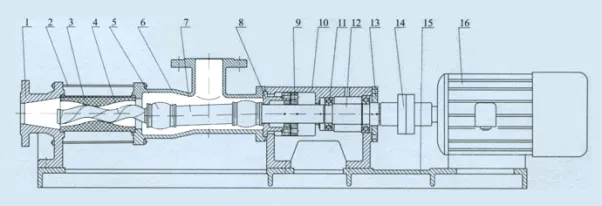1. Comparison of types
Volumetric pumps are currently available in the following categories: gear pumps, screw pumps, Roots pumps, rotary piston pumps, slide pumps, flexible impeller pumps, and so on. Cam-type Rotary Lobe Pump and screw pumps belong to the same Rotary Lobe Pump in the positive displacement pump. They are suitable for the transportation of medium and high viscosity materials, gas, liquid, solid three-phase mixture of materials and requirements of low shear materials.
Screw pump in 1932 by the French engineer Moineau invention, and by the German PCM pump company made products. Screw pumps came out to solve the previous process technology in the high viscosity, gas-liquid-solid three-phase mixing and low-shear material transportation problems, its manufacturing process and technology is relatively mature, a wide range of product applications, but the structure of the rubber stator due to process defects (rubber bushings for wear parts), has always been screw pumps in the application of the problem.

Cam-type Rotary Lobe Pump is a new product that synthesizes the advantages of gear pump, Roots pump and rotary piston pump, and is a replacement and upgrade product for screw pump, gear pump and rotary piston pump, which effectively solves the problems of screw pump; its structure and working principle are shown in the following simple diagram:

2、Comparison of pump body structure
The pump body of the screw pump consists of a metal rotor and rubber stator, the metal rotor rotates and engages with the rubber stator, and the conveying medium is driven by the helical groove on the screw and discharged in the axial direction. In the operation process of the metal rotor and rubber stator contact and produce sliding friction, resulting in the rubber stator of the screw pump is a wear parts.
Cam-type Rotary Lobe Pump pump body has two shafts, the active shaft through the helical gear driven slave shaft, thus driving the pump head and the two shafts connected to the two intermeshing metal rotor, the medium being transported by the rotor operation of the volume changes generated by the pump body to be sucked in and discharged. In the operation process rotor and rotor, rotor and pump body to maintain a certain gap between the rotor and rotor, rotor and pump body without sliding friction, theoretically no wearing parts in the pump body of the cam-type Rotary Lobe Pump (but in practice, due to the reverse role of the material flow, the rotor and pump body have a certain degree of wear and tear).
3、Advantages and disadvantages of cam-type Rotary Lobe Pump and screw pumps
Advantages of screw pumps: long application time, skillful operation and application, low rotational speed, can provide high pressure delivery (pressure up to 20Mpa).
Disadvantages of screw pumps: rubber stator in the pump body is a perishable part, high cost of late use, replacement of rubber stator and seals need to be removed from the pump body in the pipeline, maintenance and repair trouble.
Advantages of cam-type Rotary Lobe Pump: low speed, no wearing parts in the pump body, check the pump body and replace the seals do not need to remove the pump body from the pipeline, maintenance and repair is convenient.
Disadvantages of cam-type Rotary Lobe Pump: new products, the operation of the application needs guidance (different use of media is recommended to verify first), lower conveying pressure, generally below 1.6Mpa.





















































































